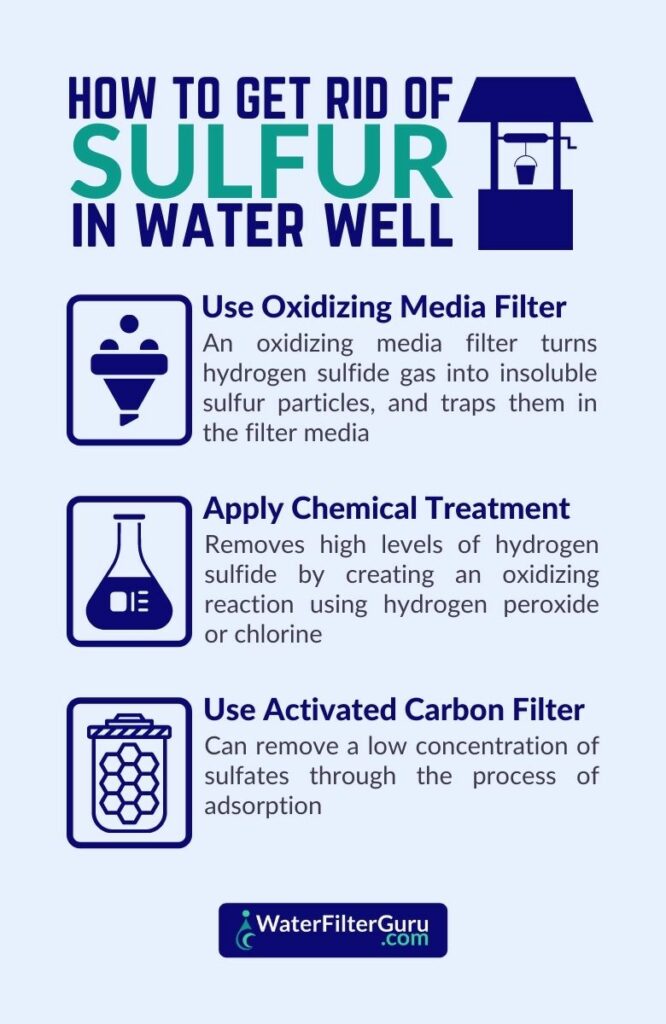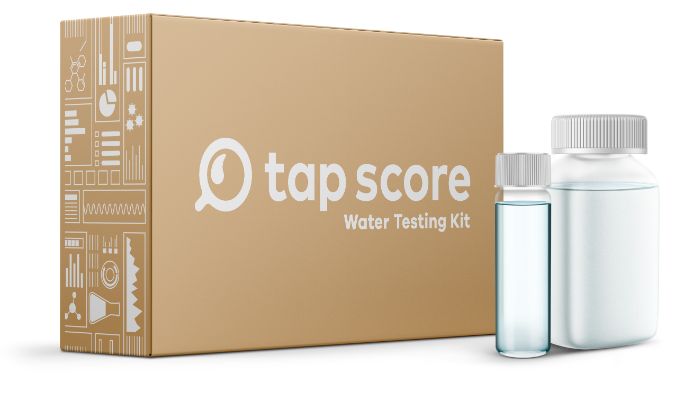Sulfur is one of the most common well water contaminants, and is associated with an unpleasant rotten egg smell and taste.
If you can smell or taste sulfur in your water, it’s a sign that you have particularly high levels of hydrogen sulfide in your water.
I don’t blame you if you’d rather not bathe in water that smells like rotten eggs – and I certainly wouldn’t want to drink it.
You shouldn’t have to put up with hydrogen sulfide in water, either, and there are plenty of ways to treat sulfur water.
In this guide, I’ll be sharing how to test for hydrogen sulfide in your water, and, most importantly, how to remove it.
Table of Contents
👃 Why Does My Well Water Smell Like Sulfur?
There are two common reasons why your water may take on a rotten egg odor:
- Sulfur has leached into your well water
- Or you’re having issues with your water heater
Hydrogen sulfate, a form of sulfur, gets into your well through rainwater or groundwater that seeps into the earth and rocks. When water passes through this organic matter, it picks up sulfur and other naturally-occurring impurities. Additionally, wells drilled in sandstone or shale may produce a noticeable sulfur odor.
Hydrogen sulfide can also build up inside your hot water heater, which can cause it to smell like rotten eggs. This typically happens when you haven’t used your water heater in a while and sulfate-producing bacteria are left to accumulate in your hot water.
A less common cause of rotten egg odor in your water heater is if you have a water softener and your water heater contains a magnesium rod. When soft water enters your water heater, it may break down the magnesium and produce high levels of hydrogen sulfide as a byproduct.
While you’re (hopefully) not drinking your hot water, you probably don’t want to wash in water that smells dirty.
💨 Causes of Rotten Egg Smell
If your water smells like rotten eggs, it’s most likely caused by either sulfur bacteria or natural organic decay.
Sulfur Bacteria
Coliform bacteria that live in soil often feed on sulfur for food or energy. The result is sulfur bacteria – and this sulfur bacteria releases hydrogen sulfur gas as a waste product.
When your drinking water has a rotten egg smell, it’s likely that sulfur bacteria is to blame.
Natural Decay in the Ground
There’s another common cause of a sulfur rotten egg smell: natural chemical reactions and decay in the ground.
The hydrogen sulfide gas released can be carried in groundwater to a well, and this water is then sent into your home via your water supply.
💥 Effects of Hydrogen Sulfide Gas
Though small amounts of sulfur are harmless, drinking water with a high hydrogen sulfide content may cause diarrhea and dehydration.
Your body can become accustomed to the mineral over a period of time, but most people would rather not risk drinking sulfur water in case of sickness.
Aesthetics-wise, sulfur gives water an unpleasant smell and taste, and you may resort to buying bottled water instead of drinking water that smells like rotten eggs.
The unpleasant water smell may cling to your clothing and linger in your home.
The problem with sulfur bacteria, aside from being unsafe to drink, is that it can encourage the growth of slimy, thick iron bacteria. This iron bacteria can clog plumbing fixtures and pipes and affect water flow.
Sulfur in the water even corrodes metals such as iron and steel.
It can also deposit black stains on laundry, damage plumbing fixtures, darken silverware and discolor copper and brass utensils with black stains.
🕵️♂️ How to Detect the Issue
First off, if you think your water contains hydrogen sulfide gas, you’ve probably noticed an obvious sign, such as a rotten egg smell.
But your well water supply may still be laced with sulfates even if it doesn’t smell – the rotten egg odor is simply a sign that your water contains enough hydrogen sulfide to cause diarrhea.
The simplest way to see if hydrogen sulfide is present in your household water supply is to test for it.
There are plenty of water testing kits online that can be used to detect contaminants in your well water, including iron, manganese and hydrogen sulfide.
These tests are affordable, usually costing less than $20, and will indicate within minutes which contaminants are present in your water.
Detecting sulfur water is easy – but identifying if the issue is associated with hydrogen sulfide gas in your ground water, your plumbing, or your water heater is slightly more challenging.
A good idea is to take a sample of water from your hot and cold water faucet. It’s important to test both your hot and cold water to determine where your hydrogen sulfide gas is coming from.
If you’re testing your well water yourself, follow the test’s instructions and dip a testing strip into each water supply sample. Then leave the strips until they’ve changed color.
If your hot water test sample has changed color to indicate hydrogen sulfide, but your cold water sample is unchanged, check out your water heaters – the issue is probably coming from there.
If both samples indicate hydrogen sulfide, you’re likely dealing with a hydrogen sulfide issue in your well.
Paying for a laboratory to test your water will give you a better idea of exactly how much hydrogen sulfide your water contains, and whether it’s coming exclusively from your well, your water heaters, or from a combination of both.
📝 How to Get Rid of Sulfur in Water Well
Once you know the cause of your water’s hydrogen sulfide odor, you can determine an action plan for getting rid of the gas from your water supplies.
I’ve shared the three most common methods used to eliminate hydrogen sulfide gas from your water below.

Oxidizing Media Filters
An oxidizing media filter uses manganese dioxide to oxidize hydrogen sulfide gas, turning it into insoluble sulfur particles, which are then trapped in the filter media.
This type of filter can also oxidize iron, another common well water contaminant.
You may also see an oxidizing media filter referred to as air injection treatment or aeration treatment.
In an aeration system, water comes into contact with an air pocket, the contaminants are oxidized, and impurity-free water leaves the system. The system requires a potassium permanganate solution for regeneration.
Chemical Treatment
Chemical treatment such as hydrogen peroxide and chlorine bleach can remove high levels of hydrogen sulfide from water (typically over 6 mg/l).
The hydrogen peroxide reacts with the hydrogen sulfide and deoxidizes it, getting rid of the bad odor. Hydrogen peroxide and chlorine bleach can also be used to treat water containing high iron and manganese levels, and can disinfect water supplies.
Rather than adding your own chlorine or hydrogen peroxide to every batch of water you plan to drink, you can use a chlorine chemical feed pump for your well.
This pump will automatically detect how much chlorine your well water requires – or you can usually set your own chlorine concentrations if you prefer – and will add it to your water to eliminate sulfur before it reaches your home.
Typically, a chlorination system will store chlorinated water in a tank before sending it to the pipes in your home.
This gives enough time for the chlorine bleach chemical reaction to take place, effectively removing the unwanted contaminants.
Any water that leaves the chlorination tank will automatically be replaced with new water from your well.
Related: Read my massive guide on well water treatment
Activated Carbon Filters
Activated carbon filtration is a suitable water treatment solution for the removal of a low concentration of sulfur contamination in water.
This type of filter can be installed at your home’s point of entry, providing your plumbing, pipes and heaters with clean, pleasant-smelling water.
An activated carbon filter uses the process of adsorption to remove sulfates and other contaminants from water.
When water passes through the activated carbon filtration media, this media attracts hydrogen sulfates, and they stick to the media’s surface. Water particles pass through the filter without being attracted to the media, which is how you end up with much cleaner, purer, odor-free water.
Generally, this type of carbon filter is combined with other stages of whole-home filtration or a reverse osmosis system, which is also capable of reducing bacteria and other pathogens, and can remove a broad range of contaminants from water.
❔ Sulfur in Well Water FAQs
What are the most common signs of sulfur in well water?
Aside from sulfur odors in your home, you may also notice black stains on your laundry, corrosion of your pipes, odors on clothing washed in water containing sulfates, stains on your kitchenware, and corrosion of your heating tank.
Will a water softener remove sulfur from well water?
Water softeners are primarily designed to reduce water hardness, and they can’t be used for removing sulfate particles from water. In high-sulfate situations, a softener may become clogged and blocked, and will perform less efficiently. A water softener may also break down the magnesium rod in your water heater and result in even more sulfate production (though you could replace this anode rod with one made from zinc or aluminum to prevent this problem).
What is the best method of sulfur removal?
It depends on what you’re looking for. Ask yourself what you want from a sulfate removal treatment. Do you want to exclusively remove sulfates? Perhaps a sulfur odor is your biggest issue at home. But if you have a high concentration of bacterial organisms or high levels of iron, you may be interested in solutions that can get these contaminants removed, too.
Your budget will have somewhat of an influence on what you can purchase for your well. There’s no cheap solution in this case, with most treatment options costing at least a couple of hundred dollars, and most requiring regular paid maintenance. While you may have to make a relatively big upfront investment, it’s for the sake of your health, so it’s certainly a justifiable means of spending your money.
How often should I be testing for sulfates in wells?
Don’t rely on the distinct sulfur odor to know it’s present in your well. Low concentrations of sulfur may not give off odors at all, which is why it’s important to carry out testing on private wells once a year, according to the EPA. Aside from sulfur, you should also test for other contaminants that commonly occur in well water, including bacteria, iron and arsenic.
What happens if my heater is the cause of the rotten egg smell?
Simple: replace the anode rod inside the heater with one made from a material that isn’t magnesium, which won’t react with your water and break down. A powered anode rod or an aluminum rod will do the job. If your heater is really old, it may be best to just replace the whole thing.
Where can I find more advice?
For more information about your private well, speak to your region’s Department of Health or check out the department’s website online. If you have specific questions about your location and how it may affect your ground water quality, it’s best to contact someone who’s in a good position to help. And, of course, if you have any reason to believe that your well isn’t safe for use, booking a well inspection from an expert will help to address your concerns.

